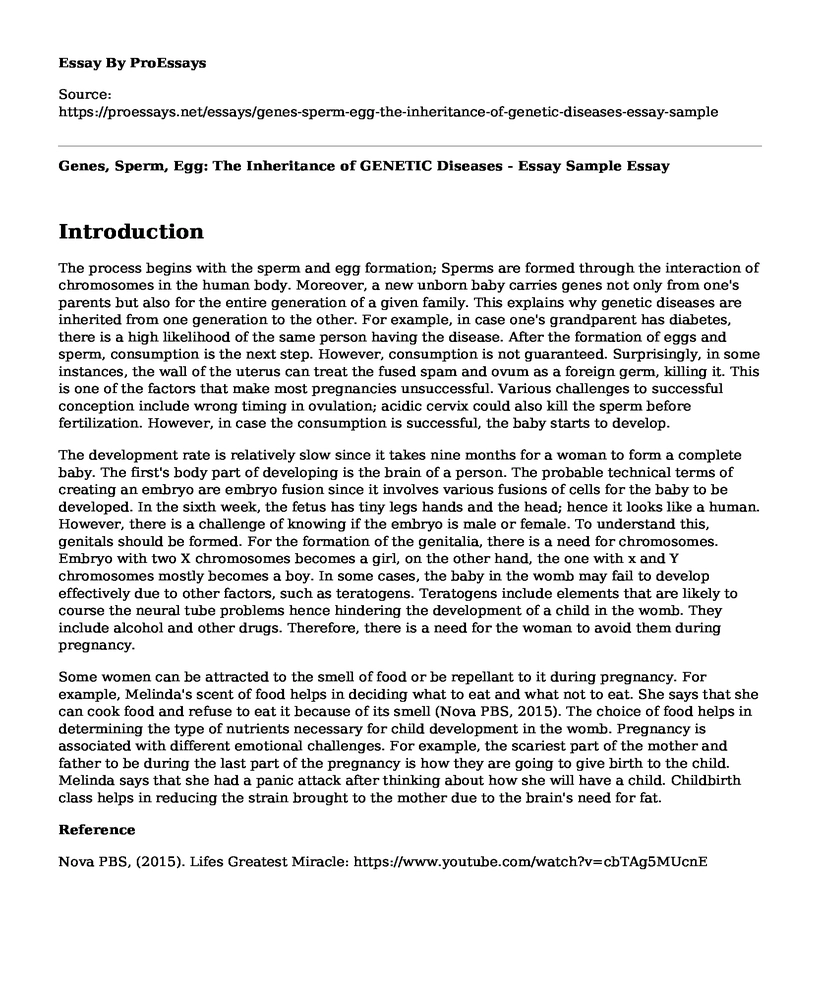Introduction
The process begins with the sperm and egg formation; Sperms are formed through the interaction of chromosomes in the human body. Moreover, a new unborn baby carries genes not only from one's parents but also for the entire generation of a given family. This explains why genetic diseases are inherited from one generation to the other. For example, in case one's grandparent has diabetes, there is a high likelihood of the same person having the disease. After the formation of eggs and sperm, consumption is the next step. However, consumption is not guaranteed. Surprisingly, in some instances, the wall of the uterus can treat the fused spam and ovum as a foreign germ, killing it. This is one of the factors that make most pregnancies unsuccessful. Various challenges to successful conception include wrong timing in ovulation; acidic cervix could also kill the sperm before fertilization. However, in case the consumption is successful, the baby starts to develop.
The development rate is relatively slow since it takes nine months for a woman to form a complete baby. The first's body part of developing is the brain of a person. The probable technical terms of creating an embryo are embryo fusion since it involves various fusions of cells for the baby to be developed. In the sixth week, the fetus has tiny legs hands and the head; hence it looks like a human. However, there is a challenge of knowing if the embryo is male or female. To understand this, genitals should be formed. For the formation of the genitalia, there is a need for chromosomes. Embryo with two X chromosomes becomes a girl, on the other hand, the one with x and Y chromosomes mostly becomes a boy. In some cases, the baby in the womb may fail to develop effectively due to other factors, such as teratogens. Teratogens include elements that are likely to course the neural tube problems hence hindering the development of a child in the womb. They include alcohol and other drugs. Therefore, there is a need for the woman to avoid them during pregnancy.
Some women can be attracted to the smell of food or be repellant to it during pregnancy. For example, Melinda's scent of food helps in deciding what to eat and what not to eat. She says that she can cook food and refuse to eat it because of its smell (Nova PBS, 2015). The choice of food helps in determining the type of nutrients necessary for child development in the womb. Pregnancy is associated with different emotional challenges. For example, the scariest part of the mother and father to be during the last part of the pregnancy is how they are going to give birth to the child. Melinda says that she had a panic attack after thinking about how she will have a child. Childbirth class helps in reducing the strain brought to the mother due to the brain's need for fat.
Reference
Nova PBS, (2015). Lifes Greatest Miracle: https://www.youtube.com/watch?v=cbTAg5MUcnE
Cite this page
Genes, Sperm, Egg: The Inheritance of GENETIC Diseases - Essay Sample. (2023, Aug 12). Retrieved from https://proessays.net/essays/genes-sperm-egg-the-inheritance-of-genetic-diseases-essay-sample
If you are the original author of this essay and no longer wish to have it published on the ProEssays website, please click below to request its removal:
- Individual Critical Reflection Paper on a Pregnant Woman
- Summary of the American Academy of Pediatrics 2010 Report
- Reflection Paper: The Plague of Athens
- Family Nursing Interventions for Health Promotion - Essay Sample
- Essay Sample on Pancreas and Diabetes: Progenitor Cells & Insulin Secretion
- Pain Management: An Inevitable Challenge for Healthcare Professionals - Essay Sample
- California Braces for $50B+ COVID-19 Impact on 20-21 Budget - Essay Sample







